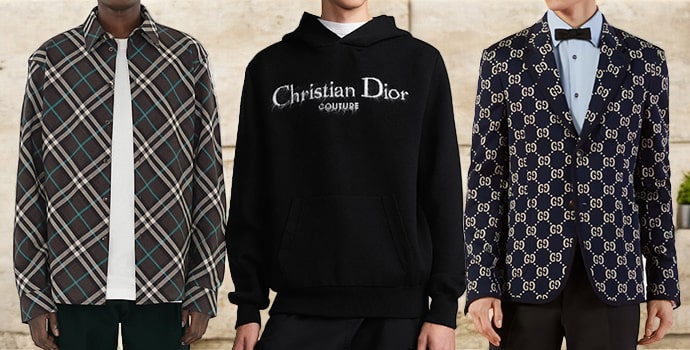Branded Clothing for Cold Climates: Which Fabrics Actually Work?
Branded Clothing for Cold Climates: Which Fabrics Actually Work?
Blog Article
Recognizing Clothing: The Significance of Textile Choices in Your Closet
The choice of fabric in clothing plays a pivotal duty in both appearances and functionality. Various products offer varying degrees of breathability, toughness, and comfort, directly affecting the user's experience. Understanding these nuances can improve one's closet substantially. Yet, lots of ignore how these choices can impact not just individual design, however likewise sustainability. What material choices could redefine your closet and straighten it with both design and obligation?
The Duty of Material in Style and Performance

Typical Fabric Types and Their Attributes
When picking apparel, comprehending the features of typical fabric types is vital for making informed options. Cotton, a widely-used all-natural fiber, is recognized for its breathability, softness, and adaptability, making it appropriate for informal wear and day-to-day garments. Bed linen, another all-natural alternative, boasts exceptional moisture-wicking homes and a distinct appearance, perfect for cozy climates.Wool, often favored for its warmth and durability, varies in fineness; merino woollen is soft against the skin, while coarser kinds are made use of for outerwear. Synthetic materials like polyester and nylon supply longevity and resistance to wrinkles, making them preferred for activewear and travel garments. Blends, which incorporate natural and synthetic fibers, can boost capability while preserving comfort. By acknowledging these fabric attributes, people can choose garments that straightens with their lifestyle and aesthetic choices.
Breathability and Comfort: Selecting the Right Fabrics for Various Climates
Picking the appropriate fabrics for various environments can greatly boost convenience and overall wearability. Breathable products are essential in hot environments, as they enable air flow and dampness evaporation. Fabrics such as cotton, bed linen, and moisture-wicking synthetics properly attract sweat far from the body, keeping the user cool and dry. Alternatively, in colder environments, thicker fabrics like woollen or fleece give insulation while keeping breathability, guaranteeing heat without overheating.Additionally, the selection of fabric weight plays a crucial duty; lightweight materials are more suitable for summertime, whereas larger options are fit for winter wear. Comprehending the unique buildings of each fabric enables individuals to clothe suitably for differing weather conditions. Inevitably, picking breathable and comfy textiles customized to specific environments can significantly boost daily comfort and improve the overall experience of wearing apparel.
Toughness and Treatment: Just How Textile Influences Long Life of Your Wardrobe
Picking the right materials can greatly affect the durability and care demands of a closet. Fabrics such as cotton and polyester are recognized for their resilience and ease of maintenance, making them excellent for everyday wear. In comparison, fragile materials like silk and shoelace need more careful handling and specialized cleansing techniques, which can boost the time and initiative required for care. Branded Clothing.Durability is additionally influenced by the material's weave and surface; tightly woven materials often tend to stand up to damage better than freely woven alternatives. In addition, synthetic blends often provide boosted durability, incorporating the best high qualities of several fibers.Understanding the treatment instructions for each and every material is essential, as improper cleaning or drying can lead to premature wear. Inevitably, picking long lasting materials can result in a longer-lasting closet, lowering the frequency of replacements and contributing to a more sustainable style selection
The Effect of Material on Fit and Silhouette

Lasting Fabric Selections: Making Eco-Friendly Decisions
The influence of textile prolongs past fit and shape to incorporate environmental aspects, triggering a growing rate of interest in lasting fabric choices. Environment-friendly fabrics, such as natural cotton, hemp, and Tencel, are gaining grip among consumers that prioritize sustainability in their closets. These products are commonly created with fewer chemicals and water, lowering their environmental footprint.Additionally, recycled textiles, made from post-consumer waste, offer an innovative service to the textile sector's contamination problem. Brands significantly accept transparency in their sourcing methods, allowing consumers to make enlightened choices concerning their purchases.Choosing sustainable materials not only supports moral practices however likewise motivates the style sector to adopt more liable production techniques. As understanding of environmental issues rises, individuals are urged YOURURL.com to assess the long-lasting effect of their textile selections, cultivating a motion in the direction of a more environmentally conscious and sustainable technique to fashion.
Raising Style: How Fabric Can Change an Attire
While many might focus on color and cut when choosing an attire, the choice of fabric plays an essential function in boosting style and boosting general look. Different products convey unique state of minds and messages; as an example, silk exudes high-end and sophistication, while jeans supplies a casual, unwinded vibe. The texture and drape of a textile can drastically modify the silhouette, with organized materials providing a sleek appearance and softer ones producing an extra fluid, kicked back aesthetic.Moreover, the weight of the textile influences wearability across seasons. Lightweight materials like bed linen and cotton are ideal for summer, while heavier materials such as woollen and velour supply heat and sophistication in chillier months. Understanding textile residential properties, such as breathability and stretch, additionally encourages people to make educated selections that improve convenience without compromising style. Ultimately, the best textile can change a clothing from common to amazing, making it an essential consideration in any type of wardrobe.
Frequently Asked Questions
Just how Do I Determine the Material Content of My Clothing?
To recognize material content, one can analyze treatment tags, conduct melt tests for fiber identification, or speak with fabric swatches. These approaches help set apart products, making certain notified options for apparel care and upkeep in everyday wear.
Can Fabric Selection Affect My State Of Mind or Self-confidence?
Textile option can considerably affect an individual's mood and confidence. Branded Clothing. Particular products may evoke sensations of comfort or sophistication, while others can feel limiting or unflattering, inevitably influencing self-perception and emotional health throughout the day
What Fabrics Are Ideal for Sensitive Skin?
For people with delicate skin, natural fabrics like bamboo, bed have a peek at these guys linen, and cotton are commonly recommended. These products are breathable, hypoallergenic, and much less most likely to cause irritation, making them ideal options for comfort and skin health and wellness.
How Do I Appropriately Wash and Look After Different Fabrics?
To appropriately clean and care for various textiles, one need to think about each material's certain demands, including temperature level setups, cleaning agents, and drying techniques, ensuring longevity and keeping the fabric's initial top qualities for excellent usage.
Exist Details Fabrics for Athletic or Performance Wear?
Athletic or performance wear frequently uses materials such as polyester, spandex, and nylon. These products are created for moisture-wicking, breathability, and versatility, improving activity and comfort during physical activities while supplying longevity and assistance. Conversely, in colder climates, thicker fabrics like woollen or fleece supply insulation while retaining breathability, making certain heat without overheating.Additionally, the choice of textile weight plays a crucial role; lightweight fabrics are more suitable for summer, whereas heavier options are company website matched for wintertime wear. In contrast, fragile products like silk and shoelace call for more cautious handling and specialized cleaning approaches, which can enhance the time and effort required for care.Durability is likewise affected by the fabric's weave and surface; snugly woven textiles often tend to resist wear and tear far better than freely woven options. In comparison, stiff textiles can limit movement but provide a classic, sleek look.Moreover, the density and appearance of the fabric can influence the visual assumption of body form. The influence of textile extends beyond fit and silhouette to encompass environmental elements, motivating an expanding interest in lasting fabric selections. The texture and drape of a textile can dramatically change the silhouette, with organized textiles providing a refined look and softer ones creating a more fluid, loosened up aesthetic.Moreover, the weight of the fabric influences wearability throughout seasons.
Report this page